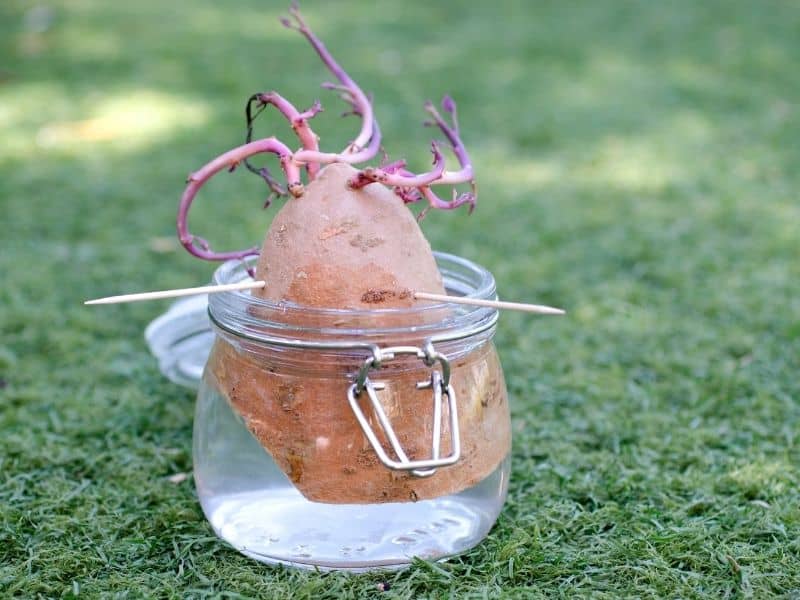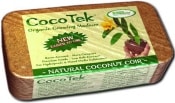So… you’re ready to start growing food in a hydroponic garden? You’ll need to use the best hydroponic growing medium if you want a healthy garden. You might have heard of perlite, Rockwool, sand, gravel, or coconut coir, amongst other mediums. Which is best for your hydro garden?
Our Beginner’s Guide To Hydroponics is on sale for a short time. Check it out!

Remember growing one of these as a child? Although you didn’t know it at the time… this was your first attempt at hydroponics!

What exactly is hydroponics? By definition: “The cultivation of plants by placing the roots in liquid nutrient solutions rather than in soil”.
Hydroponic Media Simplified
 CAUTION! You would think Lava rock would make a good Hydro medium. But it’s not. Lava rock changes the pH of the nutrient solution and releases a harmful sediment.
CAUTION! You would think Lava rock would make a good Hydro medium. But it’s not. Lava rock changes the pH of the nutrient solution and releases a harmful sediment.
The hallmark of hydroponic gardening is a soil-less growing medium… No soil! But plants need to be supported or held up somehow, right? We do this with soil-less media… inert, non-organic materials.
They do not add to or change the chemical makeup of the nutrient solution in any way. These substances are porous, light, and coarse, which allows oxygen and nutrients easy access to the plant’s roots.
If you open up any hydroponics catalog, you’ll quickly become confused by the array of hydroponic growing medium choices available today.
Yikes! Which one will be best for my garden? Glad you asked that… we’re going to make this simple and painless…
There are only 3 basic growing media that we recommend for your first gardens:
- Coconut Coir
- LECA (Lightweight Expanded Clay Aggregate)
- Perlite
That’s it. Forget about gravel or HigroMite or vermiculite or Rockwool.
There are also two advanced hydroponic techniques that don’t use any hydroponic growing medium whatsoever:
- aeroponics
- NFT (nutrient film technique)
But you’ll learn about that later.
For now, all you need to know about are the “big 3”: Coco, LECA, and perlite. Each has advantages and disadvantages, and so are better suited to specific growing systems.
Coco Coir and perlite are denser and hold water better, but LECA has superior drainage and aeration. Experienced hydroponics nuts usually have their own favorite formulas using these 3 media.
Could this get any simpler?
Alright, alright, here’s a sneak preview:
- Ebb & Flow: 2″ of LECA at the bottom; top up with 50/50 Coco & Perlite
- The Raft: the nutrient solution IS the growing medium!
- Dutch Buckets: Fill with 50/50 mix of Coco & perlite; add 1-2″ of LECA balls on top to cut down on algae growth.
- Auto pots: 50/50 Coco coir & perlite. No clay balls.
TIP: Put the LECA balls where the solution enters the system. This helps keep the lighter media (perlite & coco) from washing away.
Good news! You can sterilize and reuse all three of these growing media by treating them with a 10% bleach/water solution, then rinsing them well.
*A really easy labor-saving method for sterilizing: leave the medium in the pots. Take them outside, drench them with the bleach solution. Flush gently but thoroughly with clean water. Leave them outside to drain and dry out. We’ve even left them out in the rain for a good shower. Those pre-packed pots will be ready for the next crop!
Best Hydroponic Growing Medium
Want to learn more about these hydroponic growing media? Soil-less substrate? Great! Knowledge is power!
Let’s look in more detail at our 3 favorite growing media.
Coconut coir hydroponic growing medium
Coco coir makes an excellent planting medium for hydroponic gardens due to its excellent moisture-holding ability and inert characteristics.
Coconut coir is produced from the brown husk that surrounds the coconut shell. It is composed of millions of tiny micro-sponges, which absorb and hold up to eight times their weight in water. It is a sturdy substance, lasting three times as long as peat moss. Coco is a great addition to the hydroponics arsenal!
Coconut coir is sold in small compressed bricks which expand 6 to 8 times in volume when you add water; one brick expands to 1/3 of a cubic foot as shown below.
 |
 |
This is just one brick reconstituted with a gallon of water.
Coconut coir is also called Palm peat, coco, or just coir. One of our favorite brands of coco coir is this one made by CocoTek
Advantages and disadvantages of coconut coir
Advantages
- Superior water retention and aeration
- overall a great hydroponic medium.
Disadvantages
- Breaks down after several uses
- doesn’t drain quite as well as others. For this reason, it is often mixed with other media to improve drainage.
 You can mix coconut coir 50-50 with perlite to improve drainage or put a layer of perlite on the bottom of the growing bed before adding the coconut medium.
You can mix coconut coir 50-50 with perlite to improve drainage or put a layer of perlite on the bottom of the growing bed before adding the coconut medium.
This is coco mixed 50/50 with perlite: a super all-around potting mix for your hydroponic garden.
Coco-Coir is good for drip systems, dutch buckets, and auto pots, but not as good for ebb and flow, as it can be washed away. I put LECA balls in the bottom of my E&F pots to prevent this. Works great.
LECA (Lightweight Expanded Clay Aggregate)
L.E.C.A. makes a superb medium for hydroponics gardening because of its light weight, porosity, and inert nature.
You’ve probably seen clay balls many times and just didn’t know what it was. It’s used often in commercial decoration because it is clean and efficient. You may have seen it in a potted plant at the doctor’s office:
L.E.C.A. (Lightweight Expanded Clay Aggregate) is made by heating clay under very high heat until it puffs up, like popcorn. This results in a very coarse medium.
The balls are about 1/4″ across and have superb drainage. Sometimes they are added to denser media to help promote drainage in the planter.
Advantages and disadvantages of L.E.C.A.
Advantages
- very light, yet holds moisture
- stays put
- can be sterilized and reused many times.
Disadvantages
- doesn’t hold moisture as well as coco-coir. The solution: combine coco with the grow rocks!

Clay ball layer for top drips |

You can’t see it, but these E&F pots have a 2″ layer of clay balls in the bottoms: it won’t wash away! |
Hydroton is good for top drip pots like dutch pots; good as a base layer for ebb & flow pots.
*Tip: Rinse the clay balls before use in a colander to remove all that red dust.
Using perlite as a hydro growing medium
Perlite makes a great hydroponic planting medium due to its lightweight, porosity, and inert nature.
What is perlite?
Perlite is made by heating silica (flakes of glass) until it expands (like popcorn). Due to its low density and relatively low price, this substance is used in lightweight plasters and mortars, insulation, and ceiling tiles.
The small nodules hold water well, yet also provide excellent drainage in horticulture. This medium keeps plants more open to the air, while still
having good water-retention properties, and therefore it makes a good medium for hydroponics. It is often used as a filler and mixed with heavier media to help improve drainage.
However, you can actually grow hydroponic plants in a bucket system using nothing but perlite!
Advantages and disadvantages of using perlite
Advantages
- reusable
- inexpensive
- lightweight filler.
Disadvantages
Perlite cannot be used alone for ebb & flow, as it tends to float away or move during the flooding cycle.
Mixing with coco coir 50/50 creates a superb all-purpose hydroponic medium.
Now hopefully you’ll have your own idea of the best hydroponic growing medium for your garden.







Paula
Sunday 20th of March 2022
I am grateful for the education this write-up provided me. I'm new to hydro (houseplants) and wanted to start one in a hanging hydro pot outdoors. Your tips gave me the inspiration to combine the 3 ideal media in the new planting and I'll be able to monitor its progress.
What Is Hydroponics? A Guide For Beginners
Thursday 14th of October 2021
[…] a hydroponic garden, crops are supported in a neutral medium (like gravel or clay balls). Then you mix up a batch of the solution, which has all the essential […]
Hydroponic Lettuce Raft System - FREE Plans
Thursday 14th of October 2021
[…] Learn more about hydroponic growing media here: Hydroponic Growing Medium. […]